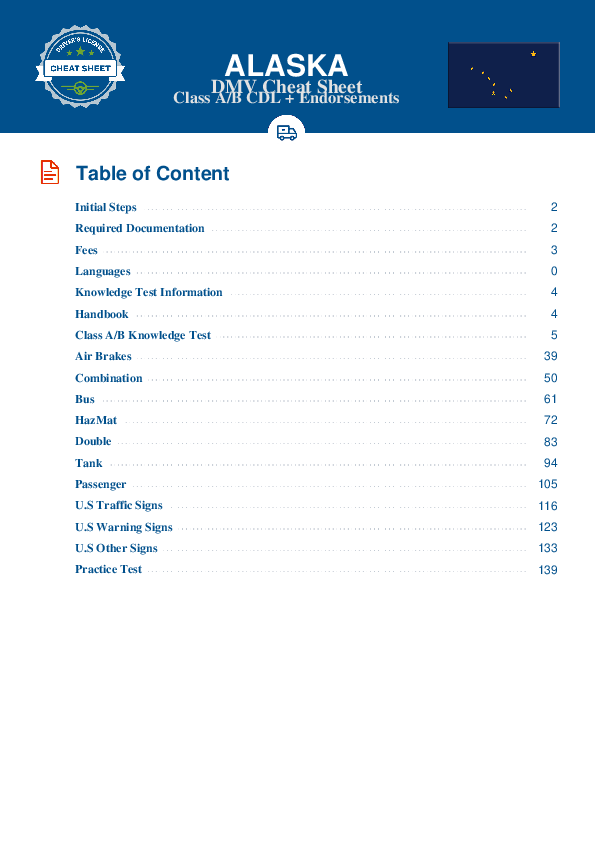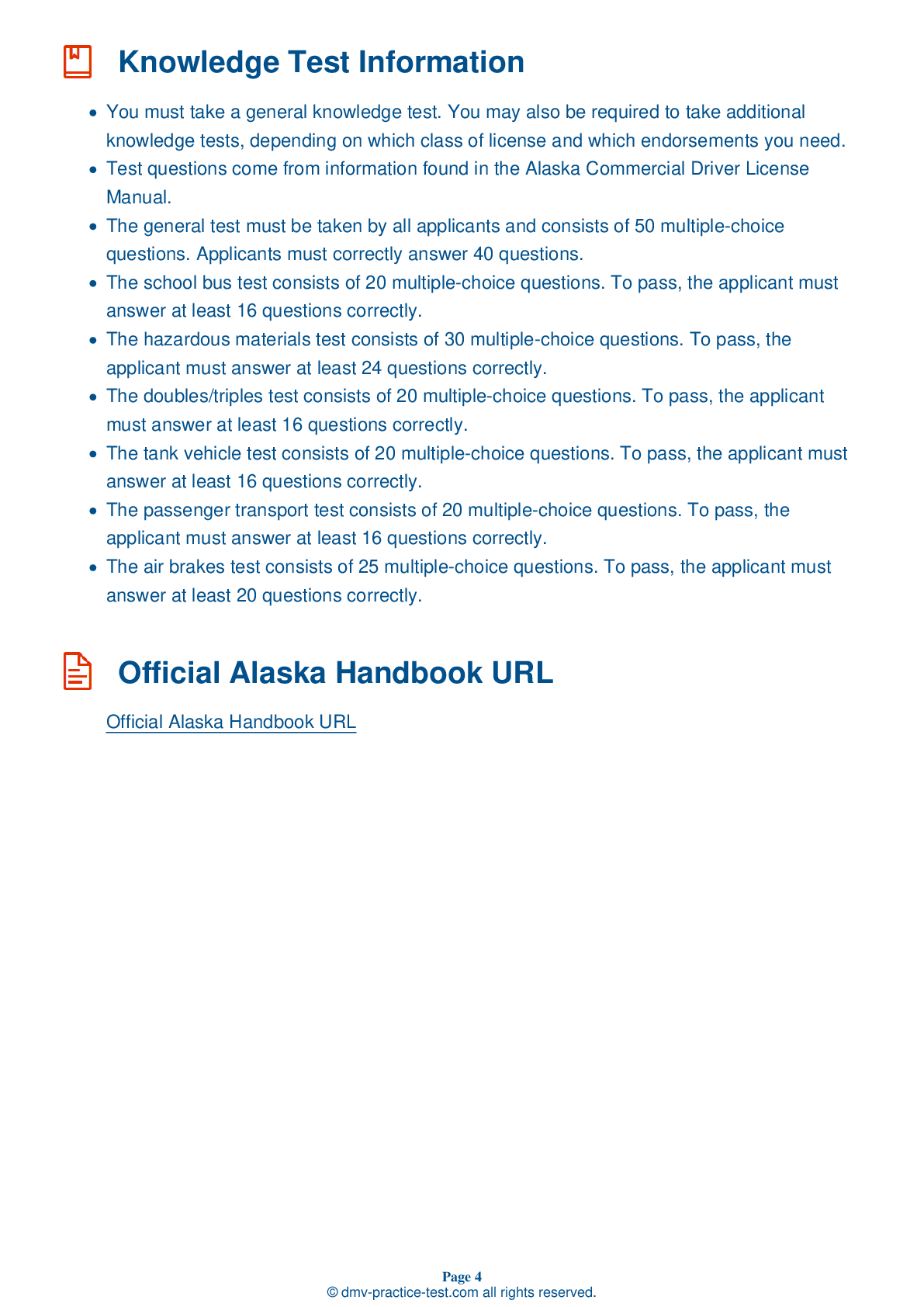Knowledge Test Class A #2
Class A Driving Test | Alaska 2025 #2 Page 6 of 7
Train for FREE online with our Alaska class A license test. The official exam test consists of several obligatory parts, with all of them checking your knowledge of different blocks of road rules. If you need to obtain a AK CDL class A permit in 2025, practice as much as possible. Free sample tests published on our website will help you check and improve your knowledge and boost your grades. Please bear in mind that CDL class A requirements may vary from state to state.
50
40
20
36 . Backing with a trailer is dangerous because:
Backing a truck is always dangerous because the driver may not be able to see everything behind them. CMV operators should avoid backing whenever possible.
37 . When taking the driving test and asked to make a turn, you should:
When asked to make a turn during the on-road driving test, you must check traffic in all directions and use your turn signal.
38 . Hanging meat in a refrigerated truck:
An operator should drive with care when transporting a cargo of hanging meat. Such a load is unstable, both because it has a high center of gravity and because the swinging of the meat can affect the driver's handling of the vehicle.
39 . Overloading a vehicle with cargo:
Overloading a vehicle can have negative effects on steering, braking, and speed control. Learn to recognize when cargo is overloaded or poorly balanced.
40 . What should you do if your vehicle gets stuck on railroad tracks?
If your CMV gets stuck on railroad tracks, you should immediately leave the vehicle and get away from the tracks. Check the signposts or signal housing at the crossing for emergency contact information and call 911, or another appropriate emergency number.
41 . Items on a flatbed:
On flatbed trailers and trailers without sides, cargo must be tied down to prevent it from shifting or falling off in transit.
42 . When using a fire extinguisher on a fire, you should:
When using a fire extinguisher, you should stand as far away from the fire as possible. Aim the extinguisher at the base of the fire, not at the flames. If you are not sure which kind of extinguisher should be used on a fire, particularly a hazardous materials fire, you should wait for the firefighters to arrive and allow them to extinguish it.
2025 Alaska | Frequently Asked Questions
A CDL Class A license in Alaska is defined as a commercial driver's license that allows holders to operate any combination of vehicles with a Gross Vehicle Weight Rating (GVWR) of 26,001 pounds or more, provided the towed vehicle is heavier than 10,000 pounds. It typically covers vehicles like tractor-trailers, truck and trailer combinations, tank vehicles, and livestock carriers.
A Class A CDL license in Alaska allows the holder to operate vehicles such as tractor-trailers, truck and trailer combinations, flatbeds, livestock carriers, and tank vehicles. The license covers any combination of vehicles with a Gross Vehicle Weight Rating (GVWR) of 26,001 pounds or more, given the towed vehicle exceeds 10,000 pounds.
To obtain a Class A CDL license in Alaska, you must be at least 18 years old (21 for interstate driving), possess a valid driver's license, pass a vision test, and complete a written knowledge test. You're also required to pass a skills test, which includes a pre-trip vehicle inspection, a basic vehicle control test, and an on-road driving exam.
In Alaska, you must be at least 18 years old to obtain a Class A CDL for intrastate driving (within state lines). However, federal regulations require drivers to be at least 21 years old to drive commercial vehicles across state lines (interstate) or to transport hazardous materials.
While specific endorsements aren't required for a Class A CDL, they allow you to operate specialized vehicles. Endorsements include H (Hazardous Materials), N (Tank Vehicles), P (Passenger Vehicles), S (School Buses), T (Double/Triple Trailers), and X (Combination of Tank Vehicle and Hazardous Materials). Each requires an additional knowledge test, and some require a skills test.
The Class A CDL skills test in Alaska consists of three parts: a pre-trip vehicle inspection to assess your ability to determine if your vehicle is safe to drive, a basic vehicle control test to evaluate your ability to control the vehicle, and an on-road driving exam where you demonstrate your ability to safely drive the vehicle on public roads.
Yes, there are limitations for Class A CDL license holders. These include restrictions based on the driver's experience, age, health status, and specific vehicle features. For instance, drivers may have restrictions if they fail the air brake portion of the test or if they drive a vehicle without a full air brake system. Also, drivers under 21 are restricted to intrastate driving.
In Alaska, the written Class A CDL test is primarily administered in English to ensure drivers can understand road signs and signals. However, the state allows the use of translators or interpreters for those who don't speak English fluently. It's advisable to contact your local DMV office beforehand to confirm their specific policies regarding language assistance.
Yes, accommodations can be made for the Class A CDL written test in Alaska if you have a disability. You need to inform the DMV about your specific needs when scheduling your test. They can provide aids such as audio versions of the test, extra time, or quiet testing environments depending on your requirements.
Yes, if you don't pass the Class A CDL written test in Alaska, you can retake it. However, you must wait at least one day before retaking the test. The Alaska DMV allows multiple attempts, but repeated failures may require additional training or instruction before another attempt is allowed. Fees may apply for each test attempt.



